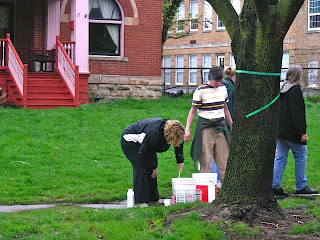Sunday, September 18, 2011
In recognition of his leadership in historic preservation and neighborhood sustainability, Mayor Michael Coleman in January 2011 was appointed by President Barack Obama to the Advisory Council on Historic Preservation. The Council protects historic buildings and neighborhoods nationwide. As the Council’s only city mayor, Michael Coleman recognizes that historic preservation is a sustainability tool that enhances and sustains community livability and economic vibrancy. Complementing the Mayor’s Get Green Columbus initiative, historic neighborhoods play a key role in the creation of attractive, healthy, and sustainable cities: their buildings in materials and construction often are inherently “green,” and they mark neighborhoods distinguished by old-growth trees and walkable streets. Indeed, it often is to these in-city neighborhoods that the “young and talented professionals” whom Mayor Coleman hopes to attract to Columbus come to live, work, and play.
Recognized within Columbus as one such neighborhood, Clintonville is distinguished by several historic prizes, prominent among which is East North Broadway Street. The National Park Service recently listed East North Broadway Street on its National Register of Historic Places—a list that constitutes “the official list of the Nation's historic places worthy of preservation.” East North Broadway Street is one of Columbus’s great historic assets. Columbus and Clintonville are proud that our street’s historic value is recognized by our nation’s federal government.
Postscript:
A big Thank You to Mary Rodgers whose tireless efforts and many hours poring over historical records made this happen.
Monday, April 18, 2011
Ash Tree Treatment a Success
Monday, April 4, 2011
Ash Tree Treatments
On April 16 and May 14, a group of volunteers will be treating ENB’s ash trees in the tree lawn between the sidewalk and the street in hopes of preventing an infestation of the destructive Emerald Ash Borer.
We’ve done extensive research and measured all of our street trees. We’ve had our treatment plans vetted and have received the go ahead from the city forester. The chemicals are purchased and now we need one more thing.... volunteers to help!
Please consider helping for just one hour, either on Saturday, April 16, or Saturday, May 14. We’ll divide into teams and quickly and efficiently treat each tree. You may want to volunteer just to learn how to do it (it’s easy) and then go home to treat the trees in your own backyard and/or those of your neighbors.
Chemicals for this North Broadway Street Association endeavor are being bought with private donations. Please consider donating by sending a check to Tom Daye, 350 ENB and specify Ash Trees on the check.
Cindy Colucy is coordinating--she would be happy to answer any questions.
P.S. Please keep pets away from street trees on those dates.
Saturday, June 26, 2010
Saving the ENB Ash Trees
Ash tree treatment in the City tree lawn will occur April 15 and May 15, 2011. More information will follow as that time draws near. Thank you to everyone to has expressed an interest in saving our trees.
Friday, April 16, 2010
James Loren by Mary Rodgers
James M. Loren, with his wife Annabel, and his partner Herman Dennison platted the North Broadway subdivision. James was born, November 20, 1849, on a farm in Plain Township Ohio Montgomery
In 1852, the family moved to Sunbury Ohio
While in Sunbury, James met Annabel McMillen. In 1878, James and Annabel married and set up residence in a home located at the corner of King Avenue Columbus , Ohio 26 W. King Ave.
During their marriage, James and Annabel had two children, a daughter Mary (married to Walter Jeffery - she died in 1904) and a son James McMillen Loren Jr. (graduate of the Ohio State University and the United States Navel Academy
The senior James Loren was a thirty-second degree Scottish Rite Mason. The Masons are a long-lived organization whose history is the premise of many of today’s movies and fictional writings. When a Master Mason receives the Thirty-Second Degree, he dons the black satin headgear of the Scottish Rite and is elevated to an order of Masonic Knighthood. So, our James M. Loren is a Knight. Interestingly, the black satin headgear used by the Masons is adorned by the double-headed eagle. That symbol appears throughout the world and is in local architecture (the chandeliers of the Greek Orthodox Church, the Athenaeum, etc.) In Mason history it is seen as the union between the masculine and feminine principles in the individual.
The Development of James Loren’s Career
When Loren first arrived in Columbus , Ohio
In 1890, the same time
During his career, Loren developed several real estate venues including but not limited to: North Broadway, Dennison Place Dennison Park Clinton Place
Interestingly, Loren also purchased land in Indian River; a small town located in Cheboygan county Michigan, and platted a clubhouse known as Columbus Beach Columbus Beach is named for Columbus Ohio
Subscribe to:
Posts (Atom)
Click here for the Legal Disclaimer concerning images and content.













